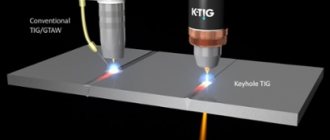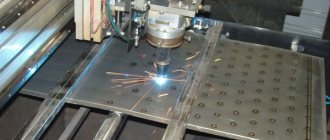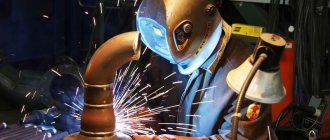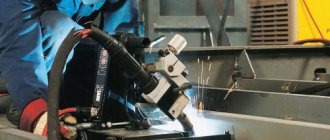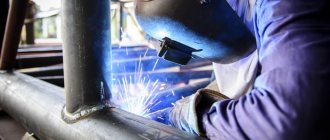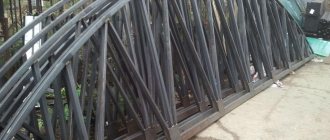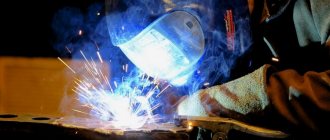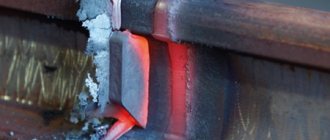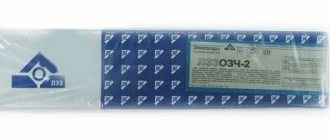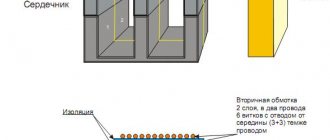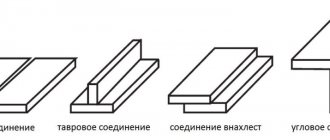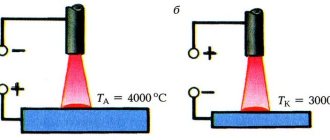Why do you need flux when welding?
The use of fluxes provides the following advantages in welding.
- In both electric arc and gas welding, the welding flux provides more intense melting of the metal (at high currents or high oxygen concentrations, respectively). Thanks to this, there is no need to cut the edges of the future weld in advance.
- In the weld area and on the surfaces adjacent to it, it is possible to avoid metal waste - its losses due to oxidation and evaporation .
- Arc burning has higher stability , which is especially important for complex seam configurations
- Energy losses of the current source for heating the metal are reduced, and its efficiency increases accordingly.
- The consumption of filler material is optimized .
- More convenient work for the welder, because the flux shields some of the arc flame.
Types of submerged arc welding
Using flux, both manual and automatic welding can be performed - the fundamental difference will depend on the equipment chosen. Electric arc welding is performed in self-regulating mode or with the support of automatic voltage control. It is optimal to use inverter units supplemented with wire feed drums. Welding with flux without gas is also common, which by default acts as a protective medium from oxygen and nitrogen. What is good about technology that eliminates this barrier to negative impact factors? Firstly, provided that a suitable flux is selected, it will be able to perform the entire list of protective and auxiliary tasks in relation to the seam being formed. Secondly, the absence of a gaseous environment facilitates the organization of the process itself. There is no need to prepare a cylinder with an argon-carbon dioxide mixture, and also to protect the welding area from excessive thermal effects when using a torch.
Conditions for using welding fluxes
The purpose of the flux is to stabilize metallurgical processes while maintaining the required productivity of the electrodes. To do this, certain conditions must be observed during the welding process.
- The flux should not react chemically with the metal of the rod and the base metal.
- The weld pool area must remain isolated throughout the welding process.
Residues of flux associated with the slag crust as a result of welding should be easily removed upon completion of work. Moreover, up to 80% of the material can be reused after cleaning.
When forging
The oldest type of welding is forging. Calling this process welding may be a stretch. However, the term “forge welding” refers specifically to the joining of two metals by forging. It is performed manually or using equipment. Forging usually involves types of steel alloys with low carbon content.
Flux for forge welding almost always contains potassium iron sulfide as a base. Its mass fraction is different, ranging from 1 part by weight to 27 parts by weight.
Other components may be borax, boric acid, sodium chloride. Before forging, the mixture is poured onto a metal billet brought to a temperature of 1000 °C.
Flux, together with scale, turns into a liquid mass of slag, envelops the working area, and protects it from further oxidation.
A competent choice of flux and welding mode guarantees the formation of a high-quality weld.
How fluxes work
- Before welding, a thick (40-60 mm) layer of flux is applied to the joints.
- The electrode is inserted into the welding zone and the arc is ignited.
- Under the influence of high temperatures (up to 6000 °C), the flux with its low density quickly melts in a gas bubble, isolating the weld pool from above, blocking access to gas, water vapor and other chemicals.
- Having a high surface tension, in the same way the flux melt prevents intense splashing of the metal.
- This allows you to significantly increase the arc current (up to 1000-2000 Amperes) without serious loss of electrode material and while maintaining good weld quality.
- Under the influence of flux, thermal power is concentrated in the arc zone - as a result, the melting of the metal occurs faster.
- In this case, all joints are filled with metal, regardless of the condition of the edges.
- The material balance of the weld changes - 60-65% of it is the metal of the parts being welded, and only the rest is the metal of the welding electrode.
Combination of flux with wire
High-quality joints of low-alloy and carbon steel workpieces are obtained using a combination of wire and flux. The properties of high-silicon compounds are better if they contain manganese. The seam is strong, smooth, and without cracks. This is explained by the small amount of sulfur passing from the flux into the workpiece and the burnout of carbon in the weld pool. The wire used is low carbon. It gives less porosity to the part.
We recommend reading: Do-it-yourself cold and hot welding of linoleum
The quality of the weld depends on the composition of the wire, and the viscosity depends on the flux containing a low amount of silicon. Such protective agents are used when joining low-alloy steels.
When carrying out welding work, the metal interacts with liquid slag. This happens for a short time before the junction cools down, but vigorously. This is due to the high temperature at the point of contact. The result is depletion or enrichment of workpieces with alloying elements. This process is influenced by:
- welding mode;
- current strength;
- arc voltage.
When connecting parts using automatic devices, these indicators do not change.
Welding fluxes - classification
The classification of fluxes is extremely broad. They are distinguished by appearance and physical state, chemical composition, method of production, and purpose. So, for example, for surfacing or arc welding, as a rule, granular or powder fluxes with certain electrical conductivity indicators are used, and for gas welding, gases, powders, and pastes are used.
According to the method of obtaining composites
There are fused and unfused fluxes.
Fused welding flux is widely used not only in welding, but also in surfacing. It demonstrates high efficiency in cases where the surface of the weld metal, by adding additional chemical elements, must obtain higher technical characteristics - for example, increased resistance to corrosion or a very even and smooth weld.
Submerged Surfacing
Fused fluxes are obtained in the following way: the components are ground, mixed, then melted in flame or electric furnaces in the complete absence of oxygen. The heated particles are then passed through a continuous stream of water, hardening and thus turning into granulate. The particle size varies - the thinner the welding rod, the smaller the granules should be.
Unmelted fluxes (ceramic) for welding are made by mixing crushed particles of a mixture of ferroalloys, minerals, and slag-forming materials without subsequent melting. The particles are mixed with glass and then sintered.
Among their advantages:
- low consumption,
- possibility of repeated use,
- high quality of the resulting seam.
An example is UF grade ceramic welding flux (UF-01, UF-02, UF-03), which is used in energy and civil engineering for welding metal structures made of high-strength low-alloy steels.
Chemical composition of fluxes for welding
Chemical composition is an important component in the characteristics of fluxes. The material must be chemically inert at very high temperatures. In addition, it must ensure effective diffusion of individual elements (for example, alloying elements) into the weld metal.
The largest mass fraction (from 35...80% of the total volume) in welding flux is usually (but not all) silicon dioxide (silica) - an acidic oxide, a colorless transparent crystalline mineral. Silicon prevents the process of carbon formation , thereby reducing the risk of cracks and pores in the weld metal.
A significant part is manganese . As an active deoxidizer, this component of welding fluxes reduces the formation of oxides in the weld pool area, reacting first with oxygen in iron oxides, then with silicon oxide. The result of a complex reaction is manganese oxide, which is insoluble in steel and subsequently easily removed. In addition, manganese reacts with sulfur, which is harmful to the weld metal—it binds with it to form sulfide, which is then also removed from the surface of the weld.
Also among the chemical elements of fluxes are alloying additives - in addition to silicon and manganese, these are molybdenum, chromium, titanium, tungsten, vanadium and others . The task is to restore the primary chemical composition of the metal, and in some cases, by alloying, to replenish the burnt-out main impurities of the steel and provide the weld metal with additional special properties. Usually in flux they are represented by compounds with iron - ferroalloys (ferrochrome, etc.).
Classification
The classification of welding fluxes has four criteria that separate the filler agent. They consist of the following points:
- purpose of flux;
- method of its manufacture;
- structure and physical parameters;
- chemical composition.
Purpose
Depending on the composition and properties of the granular product, it can be used to ensure welding processes when working with carbon, alloy and non-ferrous metals. It is used for electric arc, gas and electroslag welding, as well as work with non-consumable electrodes. Some classes of fluxes are interchangeable. Thus, flux for welding aluminum can also be used to create joints on alloy steels. It contains sodium, potassium and lithium, which will have a positive effect on other metals. “Aluminum” flux is well suited for welding with carbon electrodes. Other granular mixtures are highly specialized and not suitable for widespread use.
Preparation method
In industry, there are three methods for producing flux:
- Fused. For this purpose, electric or coal ovens are used. The components of the charge are heated to a liquid state and, when fused, form a useful mixture. Briquettes and lumps of material are broken down into small pieces. When finished, such powders have a finely dispersed gray structure.
- Mechanical mixtures. This is the combination of several types of flux into one composition by physically mixing the granules with each other. The technology is used for specific types of metals. There is no permanent composition, and production is made to order. It has a significant drawback in the form of differences in the weight and size of particles, which leads to their separation during transportation and feeding from the bunker.
- Ceramic. The connection is formed by bonding powdery substances with glue, which is liquid glass. An alternative method is sintering without fusion. The components of the charge are heated until they stick together into lumps. After cooling, they undergo a grinding procedure. By preventing fusion, alloying substances are preserved.
Structure and parameters
The appearance and physical structure of welding powders may vary. The most common are glassy grains. They have a transparent color and a round structure. They have a higher bulk density, so they tightly cover the joint, protecting it from the external environment.
The second category of fluxes is created in the form of a pumice-like substance. These are oval or round foam granules. Color can vary from white to brown. The powder, due to its light weight, requires a higher layer of sprinkling of the compound.
Chemical composition
Of the components included in the powdered substance for powdering a welded joint, low-silicon mixtures are distinguished, where the latter oxide contains less than 35%. At the same time, the participation of manganese is limited to 1%. The second group is fluxes with a high silicon oxide content, which starts from 35%. The third category is called oxygen-free.
Fluxes also differ in the degree of interaction with the base and filler metals. Passive mixtures only create a gas cloud, but do not in any way affect the chemical composition of the steel. Low alloy powders are a category of fluxes produced by melting that provide the materials being welded with a small amount of silicon, manganese, and other useful inclusions. This gives the seam greater strength and toughness. Alloying granular compositions enrich the metal to a significant extent, improving its physical and chemical properties. Seams after such welding are better resistant to corrosion.
Types of fluxes for welding by purpose
Their choice of chemical composition directly depends on the purpose of welding fluxes.
- For welding low-carbon steels, fluxes with a high content of silicon and manganese are used in combination with low-carbon steel wire without alloying additives. The second option is a small proportion of manganese (or no manganese at all) in the flux, but alloying additives are present in the steel of the welding rod.
- For welding low-alloy steels, fluxes with high chemical inertness are used - higher than for low-carbon steels. This results in a more ductile weld. An example is flux for welding steel AN-46.
- For welding high-alloy metals, fluxes with minimal chemical activity are used. Silicon, like manganese, is practically not used - it is replaced by fluorite (fluorspar), due to which easily separated fusible slags are formed. Also, such fluxes usually contain aluminum oxide and quicklime.
- To weld active metals (such as titanium), salt fluxes are used - as a rule, these are chloride and fluoride salts of alkali metals. The admixture of oxygen is completely absent in them, since it reduces the plasticity of the seam.
Flux and its purpose
It is possible to protect the weld area from slag and oxidation by using a continuous supply of chemically inert and low-melting components. Their functions are performed by protective flux for welding steel. Its different grades consist of oxides and salts and are intended for ferrous and non-ferrous metals, as well as for various alloys.
Oxide compositions include 1-30% manganese and silicon - 5-35%. For workpieces made of active alloys, the protective substance includes fluorides and chlorides of calcium, barium, sodium and other elements.
For high-alloy steels, protection containing oxides and salts is used. They contain up to 15% silica, 1-9% manganese oxide and calcium fluoride - about 30%.
To start the oxidation reaction of metals, oxygen contained in the air is sufficient. An oxide film quickly appears on aluminum parts. The presence of a flux layer prevents its formation and provides:
- active melting of metal;
- avoiding loss of welded material due to evaporation;
- stable arc burning;
- shielding part of the flame;
- correct additive consumption;
- eliminating the possibility of cracks and pores forming;
- reduction of spark spatter.
These are the positive properties of seam protection products.
Purpose of welding flux - examples
| Fused fluxes | Unmelted fluxes | ||
| AN-348-A, AN-348-AM, AN-348-V, AN-348-VM, OSTS-45, OSTS-45M, AN-60, FC-9 | Mechanical welding and surfacing of low-alloy and carbon steels with low-alloy and carbon welding wire | ANK-35 | Welding low-carbon steels with low-carbon wire Sv-08 and Sv-08A |
| AN-8 | Electroslag welding of carbon and low-alloy steels; welding of low-alloy steels with carbon and low-alloy welding wire. | ANK-46 | Welding low-carbon and low-alloy steels |
| AN-15M, AN-18, AN-20S, AN-20P, AN-20SM | Automatic arc welding and surfacing of high- and medium-alloy steels | ANK-30, ANK-47 | Welding seams of high cold resistance |
| AN-22 | Electroslag welding and automatic arc surfacing and welding of low and medium alloy steels | ANK-45 | Welding of high alloy steels |
| AN-26S, AN-26P, AN-26SP | Automatic and semi-automatic welding of stainless, corrosion-resistant and heat-resistant steels | ANK-40, ANK-18, ANK-19 | Surfacing with low-carbon welding wire Sv-08 and Sv-08A; |
| AN-17M, AN-43 and AN-47 | Arc welding and surfacing of carbon, low and medium alloy steels of high and high strength | ANK-3 | As an additive to flux brands AN-348A, OSTS-45, AN-60 to increase the resistance of seams to pore formation |
How does the composition work?
To carry out manual welding, powder or granules are poured onto the surface of the metal being welded in a thick layer. If the volume is insufficient, the workpieces are not fully cooked through, resulting in the formation of cavities and cracks. This result is undesirable, so protective fluxes of different brands are used. For carbon and low-alloy steels - AN-348 with the letters A, AM, B, VM or OSTS-45, FC-9. Automatic welding is carried out using fluxes AN-15 or 20.
Recommended reading: How to use a welding pencil
After the layer is poured, the arc is turned on or the burner is ignited and the process of joining the parts begins. Flux is gradually added to the welding zone from a special hopper through a tube. There is no splashing of liquid metal underneath, productivity increases and wire consumption decreases. The remaining protective agent is collected back into the hopper, and the frozen slag crust is removed from the workpieces.
Fluxes for gas welding
For welding aluminum and other non-ferrous metals, cast iron, tool steels, and certain grades of thin sheet steel, a protective gas atmosphere is used. It is provided by gaseous, paste, and powder fluxes. They can be applied:
- on the edges of the parts being connected;
- directly into the weld pool;
- to the filler rod.
Depending on the physical state of the material, fluxes for welding are supplied to the work area in different ways. Powdered composites cause some difficulty - they must be evenly and accurately introduced into the melt, without allowing the gas flow to blow up the powder. The compositions in the form of pastes are fed to the connection area. To supply gaseous fluxes, flow meters are used - with their help, gas is dosed into the working area.
Electromagnetic flow meter
An important point: for gas welding, the composition of the flux is selected depending on the oxides formed during welding. If they are acidic, the fluxes must be alkaline (basic); on the contrary, if they are alkaline oxides, acidic fluxes should be chosen.
The fluxes most widely used in gas welding are:
- copper, brass, bronze - for welding they use acidic fluxes containing boron-containing compounds (boric acid, etc.) - for example, brands such as MB-2 or BM-1;
- cast iron - for its welding, fluxes containing various compounds of alkali metals - sodium and potassium - are usually used;
- aluminum - compositions containing potassium, lithium and sodium fluorides, as well as chlorides, are used here. In this case, the most widely used welding flux is AF-4A.
Fluxes for gas welding are not used to join parts made of low-carbon steels, since low-melting iron oxides intensively accumulate on the surface of the molten metal.
Definition and purpose
Welding flux is a granular substance supplied to the welding zone immediately before the melting electrode and the ignited electric arc pass through this area. The substance resembles a coarse powder that can be transparent, white, yellow, green or brown.
This product is used to protect the weld pool from interaction with the atmosphere and prevent the displacement of carbon from the base metal. Some brands of fluxes additionally enrich the seam with reinforcing bonds in the form of alloying elements.
The granular substance is used in:
- electric arc welding with a consumable electrode, where the last wire comes out, fed from the reel to the torch;
- electrical welding method with coated electrodes as an additional means;
- semi-automatic welding in an inert gas environment, where the powder is located in the inner part of the tubular wire;
- gas welding with propane-oxygen flame on alloy steels and non-ferrous metals;
- electric welding with carbon electrodes.
Fluxes for automatic welding
Automatic and semi-automatic welding is most widely used when working with large structures. Thanks to high currents and flux, it is possible to weld parts of considerable thickness, without preliminary cutting of the edge. Areas of use: pipe welding, tank manufacturing, shipbuilding.
This welding method is characterized by automatic maintenance of a stably burning electric arc, the required amount of flux (with suction of unmelted), as well as continuous renewal of the molten electrode. To maintain a protective gas cloud of the required composition in the welding zone, the thickness of the flux layer should be 40-80 mm, width 50-100 mm. The brand of flux for automatic welding, as for classical arc welding, also depends on the characteristics of the metal being welded. Welding is carried out in the lower spatial position.
You can buy flux for welding of various types and brands at a profit.
Products in this category
Ceramic flux UF-03 bags TU 5929-053-00186654-2013 Ceramic flux UF-N bags TU 5929-052-00186654-2013 Ceramic flux UF-K bags TU 5929-052-00186654-2013 Flux AN 348 A mesh ki GOST 9087- 81 Flux AN 47 bags GOST 9087-81 Ceramic flux UF-01 bags TU 5929-051-00186654-2013 Ceramic flux UF-02 bags TU 5929-052-00186654-2013 Ceramic flux UF-03 bags TU 5929-053 -00186654- 2013 Ceramic flux UF-N bags TU 5929-052-00186654-2013 Ceramic flux UF-K bags TU 5929-052-00186654-2013 Flux AN 348 A bags GOST 9087-81 Flux AN 47 bags GOST 9087-81 F luce ceramic UF- 01 bags TU 5929-051-00186654-2013
Fluxes for automation
Novice workers are interested in what automatic equipment is. It helps a person to weld many types of metals. To perform tasks accurately, it is necessary to select the correct electrodes and fluxes.
The protective mixture is placed on the surface of the workpiece in a layer about 80 mm thick and 100 mm wide. Excess is removed for reuse. Flux includes oxides of aluminum, calcium and magnesium. The AN-348A, KVS or K brand is often used. The composition stabilizes the arc and reduces the release of gases with toxic properties. It is used in the manufacture of tanks, welding pipes, and in shipbuilding for welding thick layers of metal.
Welding fluxes optimize labor and give positive results that cover the shortcomings. A competent choice of a protective substance guarantees a high-quality seam.
